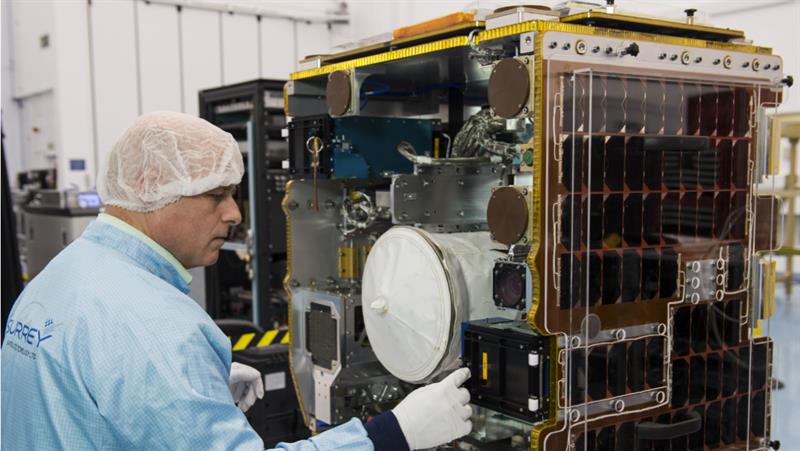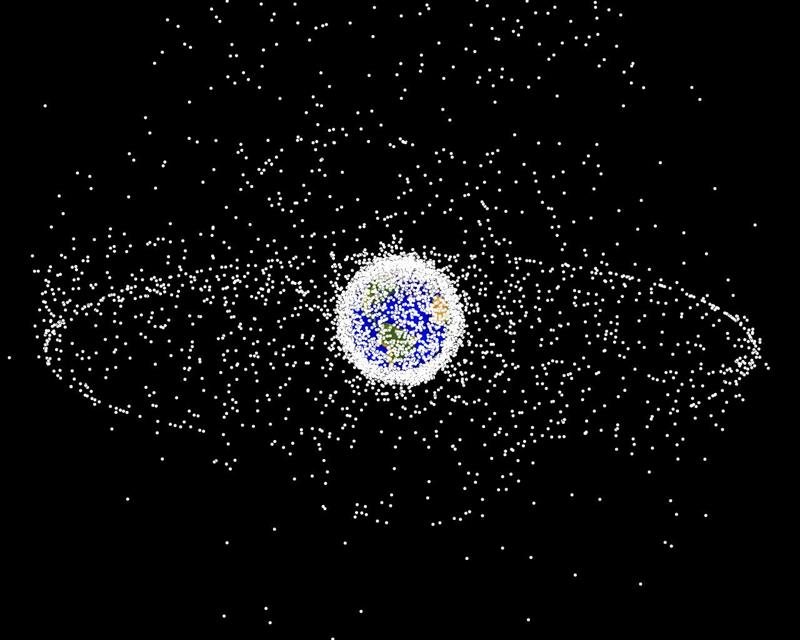The demise of China’s out-of-control Tiangong-1 space lab earlier this month, when it re-entered the Earth’s atmosphere but burned up without causing any real damage has brought into sharp focus the growing problem of space debris.
As the “Heavenly Palace” hurtled back towards Earth, an experimental spacecraft conceived by mainly British engineers was taking off aboard a SpaceX re-supply mission heading towards the International Space Station (ISS), with the remit to demonstrate the potential for Active Debris Removal (ADR).
Space junk is not restricted to large objects such as defunct satellites OR debris from previous collisions, but by tiny shards of metal and flecks of paint that could cause serious accidents if they make contact with other objects orbiting at thousands of km/h.
According to figures from NASA and the European Space Agency (ESA), over 170million items of debris threaten the Earth’s communications infrastructure and this will only get worse as SpaceX, OneWeb and Boeing plan so-called mega-constellations of satellites with up to an extra 10 000 satellites in orbit.
According to Dr J-C Liou, head of NASA’s Orbital Debris Programme, “We are tracking 500,000 pieces of junk over 1cm on a regular basis and estimate there are 23,000 objects larger than 10cm in the low earth-orbit segment.”
Worryingly, Dr Liou said, “We can’t track the millions of small pieces of debris out there and they could represent the greatest risk to space missions.”
NASA works closely with other international bodies on the mitigation of space debris through the application of standards developed and used before, during and after launch.
While Dr Liou notes that NASA is advocating that hardware designers work closely with it and other space agencies to prevent accidental collisions, it is not currently involved in the other major aspect of dealing with the threat of debris – that of mediation, or ADR. This involves sophisticated techniques to clean up junk already up there.
Much of NASA’s data comes from the US Defence Department’s Space Surveillance Network, which relies on a mix of phased array and conventional radars, electro-optical sensors and space-based sensors, tracking discrete objects measuring about 5 to 10cm diameter in low-earth orbit and about 1m in geosynchronous orbit.
“We are working hard to extend this capability to objects below this size”, said Dr Liou. Some phase- array based modules have already been developed and prototypes are currently being tested.
The nightmare scenario for all involved in space activities is the Kessler Syndrome, named after astrophysicist Donald Kessler. In 1978, while working at NASA, he published an analysis that suggested frequent collisions exponentially increase the amount of space debris, leading to yet more junk, and this could result in the loss of certain orbits.
Dr Liou acts as NASA’s chief scientist for orbital debris, a job once held by Kessler.
It’s perhaps surprising that there have not been more disastrous collisions. Arguably the most significant was in 2009 when a US Iridium mobile communications satellite and a spent Russian Kosmos 2251 collided at 26,000 mph destroying both craft and generating an estimated 2000 pieces of debris.
Space debris poses a risk to the ISS and NASA has mounted a Space Debris Sensor (SDS) to the exterior of the Columbus module that will monitor the small debris environment. The ISS already has orbital sensor shields to protect it from objects less than 1.5cm.
The SDS will provide near-real-time impact detection, using a three-layered acoustic system. The top two layers are identical and have sensors and resistive lines that are just 0.075mm wide. If any debris hits the first layer, it cuts one or more of these lines before heading for the second layer, then the particle is collected by the third, backstop, layer made of high-impact Lexan plastic. Aggregating the data engineers will be able to ascertain the debris particle size, density and velocity by using a simple triangulation algorithm.
According to NASA the backstop has sensors to measure just how hard it is hit to estimate the kinetic energy of the impacting object. Combining this with the velocity and size measurements from the first two layers, the aim is to calculate the exact density of the object. The data gathered will help scientists map the orbital debris population and design future sensors.
The ESA tracks space debris from its Darmstadt, Germany facility, but relies on data from the US Space Surveillance Network. “We clearly target our monitoring on the satellites that we are responsible for but we’re working on our own system to obtain orbital elements data,” Dr Tim Flohrer, who leads the Agency’s space surveillance and tracking department explained. “It is a hugely complex business, and the issue is not so much computing power, but the modelling involved.”
One of the ESA’s biggest targets is Envisat, an 8.8-ton remote monitoring satellite launched in 2002 that ceased functioning after 10 years of service.
As part of the Agency’s Clean Space Initiative to promote environmentally friendly innovation such as materials that burn up on re-entry and propulsion systems that minimize the amount of propellant needed for re-entry, a project dubbed e.Deorbit was developed to grab Envisat and bring it back to Earth.
Due to be implemented in 2023 using robotic arms or nets, it failed to get the necessary funding. Reports suggest the Agency is focusing on the synergies to be gained from using robotic arms for a less sophisticated method of ADR to be performed in space.
“The e.Deorbit project was looking at hugely complex tasks related to recovery technologies. It was a very ambitious and even if pared down, it’s a very worthwhile programme”, said Flohrer.
One demonstrator project that has gone ahead almost as scheduled and which was considered as an outlier for the bigger ESA programme, is RemoveDEBRIS, a public-private initiative funded to the tune of £13million by the European Commission and involving 10 leading partners including Surrey Satellite Technology (SSTL), which designed the platform and the avionics. The University’s Space Centre is the lead coordinator for the project that also includes equipment and input from ASF France; Airbus UK, responsible for the harpoon technology; Airbus Germany who designed the net; and CSEM of Switzerland.

At its core is the development of small cubical satellites, dubbed the CubeSat, measuring some 10cm cubed. These will act as ‘artificial junk’, and be incorporated into the test platform being launched.
| "We hope to demonstrate that cleaning up space debris is viable in a cost effective manner and could be taken up by commercial companies" Prof. Guglielmo Aglietti |
Four experiments are planned, to be completed by the end of the year and starting “probably by the end of May, but we need to be flexible as each experiment will rely on the space station being in the right co-ordinates,” explained Professor Guglielmo Aglietti, head of the Surrey Space Centre and principal investigator for the ‘proof-of-concept’ mission
“What hope to demonstrate that cleaning up space debris is viable in a cost-effective manner and could be taken up by commercial companies if successful. There are other options, such as using robotic arms or even lasers, but we believe we have chosen the potentially most affordable options”, he added.
Once in orbit, during the net experiment, one of the CubeSats will be released and a net fired at it. With the aid of a balloon, the small satellite will be encased in the net, slow down and fall back towards Earth and, hopefully, burn up.
A harpoon gun scheme attaches a target made of spacecraft material to a carbon-fibre boom that extends from the platform. When the harpoon hits the target, a toggle will spring out to prevent it from slipping, and the device will attempt to reel the satellite in.
The final, and most ambitious experiment, involves the satellite itself and targets an approach to deal with larger pieces of debris.
It involves a ‘drag sail’ which is a very thin membrane made of Mylar that unfolds into a square sail. One will be attached to the main spacecraft and the idea is that when the satellite reaches the end of its life, the drag sail is deployed from a stored position. Just as a sail is pushed by the wind, the drag sail is pushed by the constant stream of photons from the sun. The force generated by this stream is sufficient to drag the debris out of its orbit and cause it to spiral back towards the Earth’s atmosphere.
Dr Hugh Lewis, a senior lecturer in Aerospace Engineering at the University of Southampton and a UK delegate to the Inter-Agency Space Debris Coordination Committee (IADC), is sceptical of these proposed techniques. “I don’t think they are cost effective on a commercial basis, and the technologies are all somewhat problematic and, in the current circumstances, rather unfeasible.
| Below: RemoveDEBRIS looks to prove the commercial viability of cleaning up space junk. Credit: SSTL - Max Alexander |

“Yes, we do have a serious and fast growing problem, but we also seem to be stuck with an ‘out of sight, out of mind’ mentality. And while the agencies doing mediation work are doing an excellent job, what I am hearing from satellite operators is that collision avoidance needs to improve.”
Reassuringly, Dr Lewis noted “I don’t believe we have a catastrophe waiting to happen.”
He says there’s a lack of regulation and transparency surrounding events in space. “We have strict guidelines but few are legally binding, or enforceable. The national regulators, who are responsible for licensing the satellite operators, need to step up.”
Who is responsible for any collision; here space law, as of now, is very complicated and surprisingly lax. Every item, from a fully equipped satellite to a piece of shrapnel from a fuel tank, is owned by some legal entity.
The internationally agreed timeline for self-destruction, set out and monitored by the IADC, a governmental forum that co-ordinates the management of space junk, is that 25 years after the operational life of a satellite ceases, it should burn up in the atmosphere. “But the anticipated, and unprecedented growth from the space internet providers is causing great uncertainty”, says Dr Lewis.
| Below: The near-earth space environment, highlighting the scale of the problem |

He recently ran a 200- year simulation to assess the possible implications of this coming rise on orbital traffic, and concluded that it could lead to a 50% increase in the number of catastrophic collisions between satellites. The ESA promptly called for the satellites planned for these mega-constellations to be moved to lower orbits and be designed to burn up once their missions are over.
“The positive news is that Greg Wyler, founder and executive chairman of OneWeb, has publicly said he did not want to be the executive who messes up space”, Dr Lewis noted.
In view of these complex issues few commercial companies are involved in the business of cleaning up space. Singapore-based Astroscale, is trialling a small, lightweight plate with a ferromagnetic coating that would be fixed to a company’s satellite ahead of launch. If the satellite fails before its nominal end-of-life, Astroscale plans to launch a retriever satellite to track the spent craft and attach to the plate using a robotic arm with a magnetic end, then returning to Earth breaking up together.
A demonstration mission dubbed ELSA-d (for End-of-Life Service by Astroscale) is looking to prove the concept and if successful, and for a fee yet to be determined, the company hopes to offer the service by 2020. SSTL is supplying much of the chaser satellite’s avionics.
Californian group Aerospace Corporation is also looking into implanting new satellites with transponder packages and reflectors so that radar could more easily detect small objects and has teamed up with US defence contractor Lockheed Martin to develop a tracking system.

Another company, the Italian start-up, D-Orbit, has been testing what it calls its D3 ‘decommissioning system’ that incorporates its own intelligent motor and independent power source and communications system. The idea is to install the D-3 on satellites before launch and if something goes wrong or at the end of the satellite’s life, the motor is activated and the satellite can be safely deorbited.
| "What I'm hearing from satellite operators is that collision avoidance needs to improve." Dr. Hugh Lewis |
Luca Rossettini, CEO and co-founder said that the modular system will be suitable for satellites ranging from 50kg to over 400 kg.
“The electronics will be the same, and we think the additional cost will represent about 2% of the total cost of a satellite, less for LEO satellites. The additional weight will represent between 0.5 and 1%, depending on the size of the satellite.”
Space junk is a serious issue and there’s no doubting something has to be done to address this growing problem as we enter a new phase of satellite launches.













